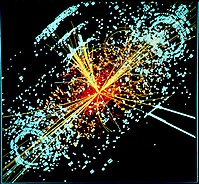
Photo from wikipedia
The intricated combinatorial structure and the non-compactness of the Lorentz group have always made the computation of $$SL(2,\mathbb {C})$$SL(2,C) EPRL spin foam transition amplitudes a very hard and resource demanding… Click to show full abstract
The intricated combinatorial structure and the non-compactness of the Lorentz group have always made the computation of $$SL(2,\mathbb {C})$$SL(2,C) EPRL spin foam transition amplitudes a very hard and resource demanding task. With sl2cfoam we provide a C-coded library for the evaluation of the Lorentzian EPRL vertex amplitude. We provide a tool to compute the Lorentzian EPRL 4-simplex vertex amplitude in the intertwiner basis and some utilities to evaluate SU(2) invariants, booster functions and $$SL(2,\mathbb {C})$$SL(2,C) Clebsch–Gordan coefficients. We discuss the data storage, parallelizations, time, and memory performances and possible future developments.
Journal Title: General Relativity and Gravitation
Year Published: 2018
Link to full text (if available)
Share on Social Media: Sign Up to like & get
recommendations!